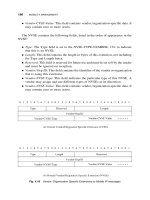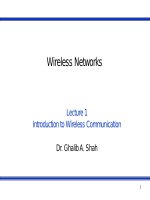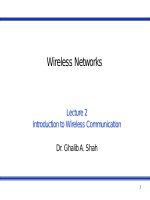Wireless networks - Lecture 6: Multiple access techniques
Bạn đang xem bản rút gọn của tài liệu. Xem và tải ngay bản đầy đủ của tài liệu tại đây (661.81 KB, 24 trang )
Wireless Networks
Lecture
Multiple Access Techniques
Dr. Ghalib A. Shah
1
Outlines
Review of previous lecture #5
FDMA
TDMA
CDMA
Random Access
► ALOHA
► Slotted ALOHA
► Reservation-based ALOHA
Summary of today’s lecture
2
Last Lecture Review
Block Codes
► Hamming
► BCH
► Reed Solmon
ARQ
► Sliding window
► Go-back-N
3
Multiple Access Techniques
Frequency Division Multiple Access
(FDMA)
Time Division Multiple Access (TDMA)
Random Access
Code Division Multiple Access (CDMA)
4
User 1
User 2
User 3
User 4
Time
y
nc
ue
FDMA was the initial multiple-access
technique for cellular systems
Separates large band into smaller
channels.
Each channel has the ability to
support user.
Guard bands are used to separate
channel preventing co-channel
interference
Narrow bandwidth (30 khz).
Fr
eq
e do C
FDMA
f1
5
Advantages
► Simple to implement in terms of hardware.
► Fairly efficient with a small base population and with
constant traffic.
Disadvantages
► Network and spectrum planning are intensive and
time consuming.
► Channels are dedicated for a single user, idle
channels add spectrum inefficiency.
6
Us
er
4
U
se
r2
e do C
1
er
s
U
Time
nc
y
ue
Entire bandwidth is available to the
user for finite period of time.
Users are allotted time slots for a
channel allowing sharing of a single
channel.
Requires time synchronization.
Each of the user takes turn in
transmitting and receiving data in a
round robin fashion.
Fr
eq
U
se
r3
TDMA
7
How it works?
User presses Push-to-Talk (PTT) button
A control channel registers the radio to the closest base
station.
The BS assigns an available pair of channels.
Unlike FDMA, TDMA system also assigns an available
time slot within the channel.
Data transmission is not continuous rather sent and
received in bursts.
The bursts are reassembled and appear like
continuous transmission.
8
Advantages
►
►
►
Extended battery life and talk time
More efficient use of spectrum, compared to FDMA
Will accommodate more users in the same spectrum space than an
FDMA system
Disadvantages
►
►
►
►
►
Network and spectrum planning are intensive
Multipath interference affects call quality
Dropped calls are possible when users switch in and out of different
cells.
Too few users result in idle channels (rural versus urban environment)
Higher costs due to greater equipment sophistication
9
CDMA is a spread
spectrum technique used
to increase spectrum
efficiency.
SS has been used in
military applications due to
anti-jamming and security.
e do C
CDMA
User 4
User 4
User 3
User 2
Fr
eq
ue
nc
y
User 1
10
Time
CodeDivision Multiple Access (CDMA)
Basic Principles of CDMA
► D = rate of data signal
► Break each bit into k chips
•
Chips are a userspecific fixed pattern
► Chip data rate of new channel = kD
11
CDMA Example
If k=6 and code is a sequence of 1s and 1s
► For a ‘1’ bit, A sends code as chip pattern
•
<c1, c2, c3, c4, c5, c6>
► For a ‘0’ bit, A sends complement of code
•
<c1, c2, c3, c4, c5, c6>
Receiver knows sender’s code and performs electronic
decode function
•
•
Su d
<d1, d2, d3, d4, d5, d6> = received chip pattern
<c1, c2, c3, c4, c5, c6> = sender’s code
d1 c1 d 2 c 2 d 3 c3 d 4 c 4 d 5 c5 d 6 c6
12
CDMA Example
User A code = <1, –1, –1, 1, –1, 1>
► To send a 1 bit = <1, –1, –1, 1, –1, 1>
► To send a 0 bit = <–1, 1, 1, –1, 1, –1>
User B code = <1, 1, –1, – 1, 1, 1>
► To send a 1 bit = <1, 1, –1, –1, 1, 1>
Receiver receiving with A’s code
► (A’s code) x (received chip pattern)
•
•
•
User A ‘1’ bit: 6 > 1
User A ‘0’ bit: 6 > 0
User B ‘1’ bit: 0 > unwanted signal ignored
13
Advantag e s
►
►
►
►
►
Greatest spectrum efficiency:
CDMA improves call quality by filtering out background noise, crosstalk, and interference
Simplified frequency planning - all users on a CDMA system use the
same radio frequency spectrum.
Random Walsh codes enhance user privacy; a spread-spectrum
advantage
Precise power control increases talk time and battery size for mobile
phones
Dis advantag e s
►
►
►
Backwards compatibility techniques are costly
Currently, base station equipment is expensive
Low traffic areas lead to inefficient use of spectrum and equipment
resources
14
Rando m Ac c e s s
Rando m Ac c e s s Me tho ds
► mo re e ffic ie nt way o f manag ing me dium ac c e s s
fo r c o mmunic ating s ho rt burs ty me s s ag e s
• in contrast to fixed-access schemes, each user gains
access to medium only when needed -has some data to
send
• drawback: users must compete to access the medium
(‘random access’)
• collision of contending transmissions
Rando m Ac c e s s Me tho ds in Wire le s s
Ne two rks
► c an be divide d into two g ro ups :
• ALOHA based-no coordination between users
• carrier-sense based-indirect coordination -users sense
availability of medium before transmitting 15
Random Access
Collision Period
User 4
User 3
User 2
rescheduled
User 1
Time
16
ALOHAbas e d Rando m Ac c e s s
us e r ac c e s s e s me dium as s o o n as it has a pac ke t
re ady to trans mit
► after transmission, user waits a length of time >round-trip
delay in the network, for an ACK from the receiver
► if no ACK arrives, user waits a random interval of time (to avoid
repeated collision) and retransmits
advantages:
► simple, no synchronization among users required
disadvantages:
► low throughput under heavy load conditions
► probability of collision increases as number of users increases
max thro ug hput = 18% o f c hanne l c apac ity
17
Pure-ALOHA
18
Slotted ALOHA
time is divide d into e qual time s lo ts –whe n a us e r
has a pac ke t to trans mit, the pac ke t is buffe re d and
trans mitte d at the s tart o f the ne xt time s lo t
► BS transmits a beacon signal for timing, all users must
synchronize their clocks
advantages:
► partial packet collision avoided
Disadvantages
► throughput still quite low!
► there is either no collision or a complete collision
max thro ug hput = 36% o f c hanne l c apac ity
19
Slotted ALOHA
20
Example
s lo tte d ALOHA in GS M
► Two type s o f c hanne ls in GS M:
• Traffic c hanne ls (TCH): used for transmission of user data
–based on FDMA/TDMA
• Signalling channels, used for control and management of a
cellular network
• Rando m Ac c e s s Channe l (RACH): signalling channel for
establishing access to the network (i.e. BS)
• employs Slotted ALOHA
• only channel in GSM where contention can occur
21
Re s e rvatio n ALOHA
Time s lo ts are divide d into re s e rvatio n and
trans mis s io n s lo ts / pe rio ds
► during reservation period, stations can reserve future slots in
transmission period
► reservation slot size <
advantages:
► higher throughput under heavy loads
► max thro ug hput up to 80% o f c hanne l c apac ity
disadvantages:
► more demanding on users as they have to obtain / keep
‘reservation list’ up-to-date
R-Aloha is most commonly used in satellite systems
satellite collects requests, complies ‘reservation list’
and finally sends the list back to users
22
R-ALOHA
23
Summary
FDMA
TDMA
CDMA
Random Access
► ALOHA
► Slotted ALOHA
► Reservation-based ALOHA
Next Lecture
► Carrier-sense based random access
► Spread Spectrum
24









